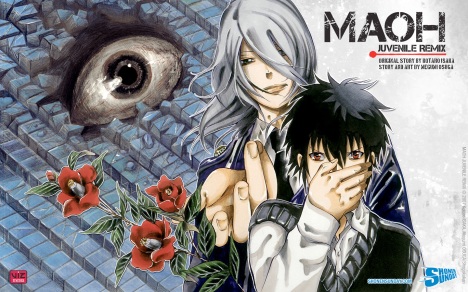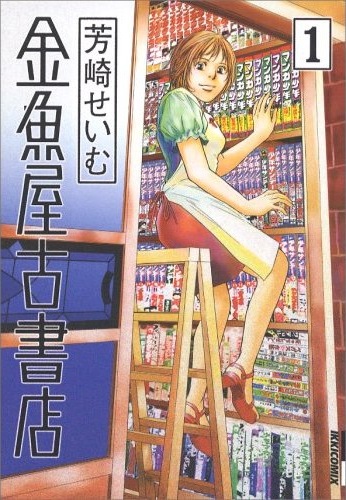
Nothing like a pervy businessman groping a timid schoolgirl to kick off a shōnen series. Unless it’s a teenager with mind-control powers making said timid schoolgirl scream accusations at said businessman in front of the entire train car. Now that’s a manga I can get into.
A shōnen manga with a slightly dark atmosphere, MAOH: Juvenile Remix focuses – at least in the beginning – on Ando, a high school student who has the strange ability to make people say what he wants. More than anything, Ando wants to just be normal but when he gets particularly angry or upset his power has a way of coming to the surface. During a run-in with some thugs, he comes face-to-face with Inukai, the mysterious and charismatic leader of a vigilante group known as the Grasshoppers. At first Ando dismisses him as a pretty boy blowhard, but is impressed by the way he takes on the leader of the gang.
As it turns out, Inukai seems to have an agenda of his own. In chapter two he butts heads with the councilman about his city revitalization plan and announces that he will be the one to save the city, and in the first panels of chapter three we see that the councilman won’t be standing in Inukai’s way. I think it’s safe to assume that he has some powers of his own, but for now they’re remaining hidden from both Ando and the reader. I enjoy stories like this, ones that remind me a little of a detective story that crashed headfirst into a dark high school fantasy. The characters are likable as well, even cheerful, carefree Junya and his too-cute girlfriend Shiori. What we’ve seen of Inukai and his Grasshoppers has become progressively more sinister and I’m interested to see how their part of the story plays out. Also, whether or not that’s lipstick in the center of his lips to go with his eyeliner. The guy’s kind of hot in a visual kei sort of way.
MAOH ran in Weekly Shōnen Sunday for two years, and with only three chapters up on Viz’s Shonen Sunday website it looks like it’ll be a while before we see the end unless they decide to pull it and release the tankoubon on a schedule like their current series. I’m already hooked on it and am hoping for the latter so I won’t have to wait another month to find out what happens with Ando’s classmate and the bullies. Creepy.
Filed under: manga | Tagged: kotaro isaka, manga, maoh, maoh juvenile remix, megumi osuga, serial, shonen sunday, shōnen | 3 Comments »


 The publishing industry is seeing hard times these days and manga publishers are no exception. After discontinuing Shojo Beat, Viz tried something new by launching their Shonen Sunday imprint and website. Not content to stop there, they also created
The publishing industry is seeing hard times these days and manga publishers are no exception. After discontinuing Shojo Beat, Viz tried something new by launching their Shonen Sunday imprint and website. Not content to stop there, they also created 
 Many years ago, the first exposure that I and many budding otaku my age had to manga was through Rumiko Takahashi in the form of Ranma 1/2. It was one of the first widely distributed manga series in the United States and whether they loved it or hated it, just about everyone had read Ranma. Later, Inu-Yasha would become a smash hit, and her other series such as Maison Ikkoku, Mermaid Saga and One-Pound Gospel also did well. There’s only one problem as far as I’m concerned – these days she doesn’t know when to quit.
Many years ago, the first exposure that I and many budding otaku my age had to manga was through Rumiko Takahashi in the form of Ranma 1/2. It was one of the first widely distributed manga series in the United States and whether they loved it or hated it, just about everyone had read Ranma. Later, Inu-Yasha would become a smash hit, and her other series such as Maison Ikkoku, Mermaid Saga and One-Pound Gospel also did well. There’s only one problem as far as I’m concerned – these days she doesn’t know when to quit. I had been starting to lean in its direction for a little while now due to the diverse assortment of stories it features. Korean, Japanese and English all under one roof in a double-sided magazine – what’s not to love? For me, it’s this series.
I had been starting to lean in its direction for a little while now due to the diverse assortment of stories it features. Korean, Japanese and English all under one roof in a double-sided magazine – what’s not to love? For me, it’s this series.










